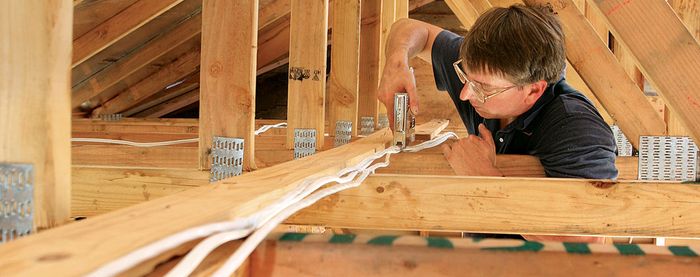Subpanel Installation: Running and Connecting the Power Feed
Once the box is securely in place, it's time to bring in the cables that will carry current from the main panel.
Video transcript:
I’m going to feed the main line in from underneath. You have to be really careful when you’re feeding large-gauge wire through the concentric knockouts because you can definitely dislodge them as you’re wrangling with it. As a general rule of thumb for how much wire to leave, I’ll come up the side of the box, over, and about halfway down the other side to be sure I have enough. To secure this wire, I make a cable clamp connection. You don’t want to crush the wire as you’re tightening this, but you also want to make sure that it’s not going to move around. Then, use a pair of channel locks to make sure it’s good and snug. Now that it’s secure, I can go ahead and split off this sheathing. Nick the end of the wire with a utility knife. The bigger the wire, the tougher the jacket generally, so you may have to actually score it. It’s better to pull it loose, because you don’t have to worry about scoring the wire on the inside. This is still Romex, so I want to leave a little bit of the jacket on the inside of the panel.
This wire is a four-wire, which means I have the two hots—black and red—a white neutral, and a bare ground. At this point, on a main electrical panel, the neutrals and grounds will be electrically connected, heading out to the meter. In the case of a subpanel, I don’t want that; in the event that the neutral were to ever be disconnected, you will be relying on the ground to carry the neutral current back to the main panel. The ground is connected to everything else that’s metal—so you touch anything metal, and you might be in trouble.
Before I go too much further, I’m going to install this ground bar kit. Since this is a four-wire service, I need a separate bar within this panel to hook up all the bare ground wires. This bar is designed to fit with this panel. There are three little holes in it, two of which fit over the bumps on the back. The middle provides a screw hole through which I can secure it to the enclosure. The screw not only keeps it secure, but it also provides that electrical connection to the panel itself. They sell this bar separately because it’s not used for a main, three-wire service. With the ground bar installed, I can make the connection from the ground wire to the bar, which will carry the ground all the way back to the main panel.
Next, I can carry on with the neutral, which will end up right here. With thicker wire like this, you have to do some pre-planning to make sure you can get the radius you need to get to that lug. So, it might make logical sense to come this way and dump it right back down, but in terms of wiring with something this thick, I’m actually going to bring it up the other way. I’ll fold it into this corner. On larger-gauge wire it definitely helps to give it a little bit of a bend first.
So, now that I’ve got it looped around the way I want it, I’m going to put my finger where I want to make the cut so that it’ll sit down in this neutral lug, nice and clean. A No. 4, you can usually get by with a pair of side cutters to clip it. Before I make this neutral connection, obviously I have to loosen up the lug. This lug is only about ½ inch wide, so I need only about ½ inch of exposed conductor here to make the connection. I’ll leave a little extra, because when I crank down on it, I’m going to end up flattening that strand of wire a little bit—so I want enough to make a good solid connection on that lug. I’ll just take my utility knife and lightly score around it about ¾ inch, all the way around. Then I’ll poke in there just a little bit and score it out all the way to the end, peel off the layers, and expose the conductor. Even though I’m using copper wire, it’s a good idea to put a little antioxidant on the actual connection. It’s more of an issue with aluminum connections, but it’s a good habit to get into if you’re running aluminum service wire.
I’m going to do the same with the hot conductors. The order in which to connect the black and the red doesn’t really matter; red on the right, if you want to make it easier to remember. Expose the conductor, and hit it with a little bit of no-ox. Loosen the lug a little bit more; sometimes stranded wire has the tendency to catch on things. If it gets hung up at all, it’s not a bad idea to pull it back out to make sure you haven’t split a strand off. I’ll get the last one done, and then I’m ready to do the branch circuits.
At this point, I’ve finished installing the wires in the subpanel coming from the main panel.
View the other videos in this members-only video series:
- Fitting and Fastening the Box
- Running the Main Power Feed
- Connecting Circuits and Breakers
- Subpanel Safety Tips





